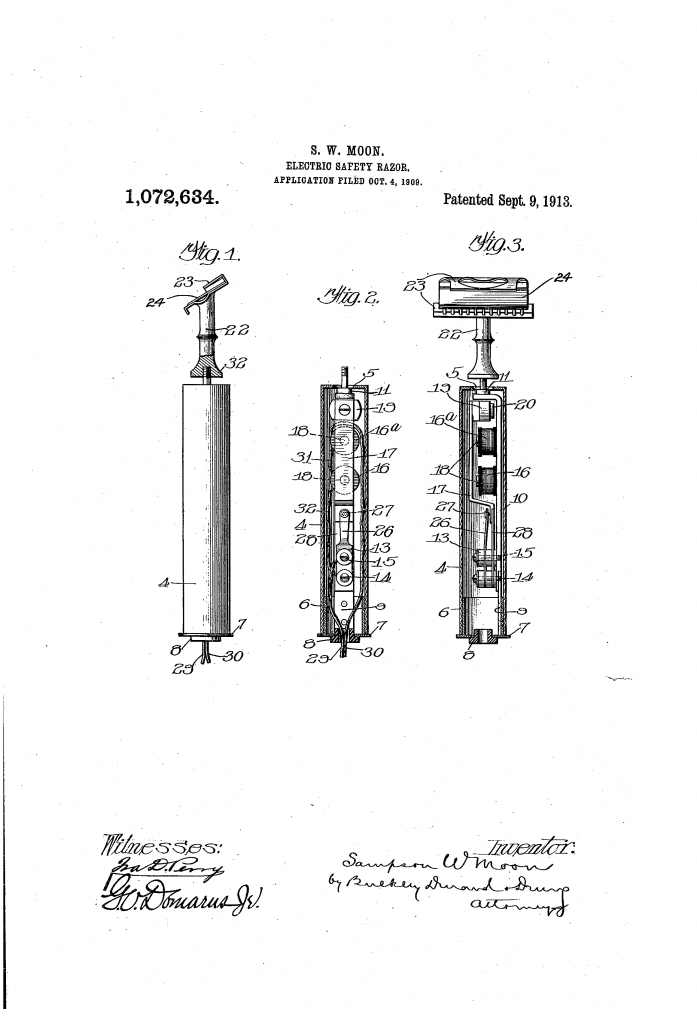Shaving. A relaxing daily ritual involving water, soap, sharp blades, and – if Sampson W Moon had gotten his way – a risk of a shocking shave. Hot towels, scented lather, and then a casual electrocution. Sounds wonderful.
We’ve looked at a few electric razors before, both battery powered and ones you would plug into the grid. And one that could double as a wood planer… quite terrific stuff. At least Sampson’s invention is not the most scary of the bunch.
Once the modern safety razor was invented, people sought to improve on it.1 One of the many avenues explored was to make the blade move under it’s own power.2 Usually by electricity, even if at least once inventor opted for a flexible shaft. Battery technology was quite primitive back in 1909, so Sampson choose to wire his razor to the grid:
The device may be used on the ordinary electric light circuit, or any other source, by placing a suitable resistance (not shown)` in the circuit to prevent the burning out of the coils 16 and 16a.
From US patent 1,072,634
The mechanics of the invention is fairly simple, seen from today. Two live wires carries power from the grid into the razor. As the current alternated,3 the coils would attract and repel an anchor. This would cause the entire structure to vibrate, causing the blade to move sideways in it’s frame.
Which supposedly improves the shave. To quote once again:
In the use of the ordinary safety razor the hair of the beard is cut by a direct pull, and the operation is often very unsatisfactory, especially if the beard happens to be stiff or the razor dull. By the use of my device, however, the sidewise movement of the razor blade, moving with the frame, performs the cutting operation, the razor being drawn lightly over the face. It will be noted that, as the beard is not cut by a direct pull, the blade has to simply move slowly over the face in order to bring the moving blade against the hairs of the beard and the disagreeable pulling of the beard is entirely done away with and the user relieved om the necessity of exercising any special care or skill in the manipulation of the razor.
From US patent 1,072,634
There is no switch visible meaning that to stop the shaking, the shaver would have unplug the razor. Possible with wet hands. A possible shocking shave indeed.

His 1909 filing isn’t Sampson’s only foray into electric razors and vibrator machines.4 And like his other inventions, this one does seem to have sunk without a trace. The idea of making your razer shake, rattle, and roll on the other hand… that is still with us. Even if it should be well known that a razor is not a saw.
Anyone can use Sampson’s invention for a shocking shave, since the patent is long expired. But why? The invention was meant to make shaving easier with a dull blade on a stiff beard. Today we can easily and cheaply get fresh, sharp blades that would give us a nice relaxing shave. Without, I might add, the risk of a shocking shave.
You can read the full patent Google Patents, as usual.
Footnote:
- Often failing to grasp the simple concept that “Perfection is achieved, not when there is nothing more to add, but when there is nothing left to take away.“
- An idea the big multinationals are still pushing with the latest crop of horrid plastic cartridge razors.
- Grid current is alternating, unlike the direct current from a battery.
- For… giving massages. I’m sure that was the only use intended, despite the design of some of the attachments.
